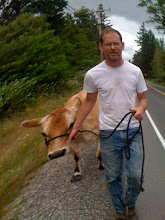
I got a bit too big for my britches. Or at least, I was lucky for a while.
Throughout the summer, through the fall and then into winter, the cheese making business was a pleasure. Not perfect, not always easy and certainly a challenge, but I was making good cheese. And oftentimes I made great cheese. I felt that I was set and nothing could bring me down. And then one day it all ended.
Around the first of December I got a text message from Jorge, who works for me here on the Farm, while I was in the city delivering cheese that there was a problem. He grasped that this change in the cheese made the day before was not right.
Usually the cheeses rest overnight and then in the morning are ready to be unmolded and salted and to further drain and dry. This batch on that cold, December morning were liberated from their molds and promptly fell apart. They were not cheese by any definition, but rather some loose curds that couldn't hold a form. When I returned home late that evening I found the draining table covered in wet curds.
Cheese making is unlike anything else I have ever done. I believe that most people think it is akin to cooking -- add a little of this, cook it a little till done, season till you like it and so on. Sadly, it bears little resemblance to cooking. It is more like a science project. The reactions are chemical in nature with very little room for error.
And so I spent the next two weeks after the curd collapse making batches of cheese and trying to find the condition or the process that had exceeded its variance. There are many, many such important points in the making process that can affect the final outcome. The temperature in the room, the age of the milk (one day old, two days old, three days old), the pH of the milk, the age of the cow that produced the milk, how late the cow(s) are in their lactation, the temperature of the milk at any number of numerous points in the twenty four hour process and so on. It is a lengthy list and I needed to check each one.
After two weeks I still was making soggy curds that could not be called cheese. This was an interesting challenge, one that I was fascinated about except that this wasn't in a classroom, this is my business. An article had just come out in the local paper and the demand for this luscious Dinah's Cheese went way up, just as my supply diminished to nothing. Nothing.
And then I isolated the problem. Through a continual checking of the pH of the milk, I realized that the pH was not dropping when it should be. The only possible cause was the starter cultures that I was adding were dying. Now I knew the problem, but not the reason for it. I then called in a couple of favors and asked people far more experienced than myself.
Margaret Morris at Glengarry Cheese Supply in Ontario quickly identified the problem as Bacteriophage. I had never heard of this and was astounded to find out that such a serious problem was not in my playbook. These phage, are airborne viruses that feed on whey spilt on the floor of the cheese making room. They have a most unpopular characteristic -- they have the ability to kill the cultures that are added to milk. Now that I had identified the problem I needed to find the remedy.
David Gremmels, an old friend and now the owner of Rogue Creamery and the President of the American Cheese Society, filled me in on how to combat these pesky phage. The whey is immediately removed from the make-room; the floors, walls and often ceilings are often bleached; everything in the room is constantly disinfected, bleached and rinsed; anyone entering the make-room walks through a disinfectant bath and then their boots are changed as well; and the cultures are changed daily to confuse the phage.
This sounded much more like a job all of a sudden rather than this fun project on one corner of the farm. Jorge and I stepped up to the challenge, bleaching everything in sight, adding new boots just for the make-room, and installing a bleach mat to walk through before entering.
Thankfully, this seems to have worked to kill or at least to keep the phage is check. New cultures have indeed managed to put these phage on the defensive, allowing my cultures to grow and multiply in the fresh, warm, sweet milk.
And so now I can say that the curing cases are filling up again with new cheeses. In a few days time they will be ready to be delivered to the city: ripe, melting with gooey centers, a bright, white rind holding it all in. I must admit that there were a few days that I didn't think I would ever find the problem, as each failed batch was thrown into a bucket and dropped into the pig pen for the hogs to devour. Only now is this a good story.






